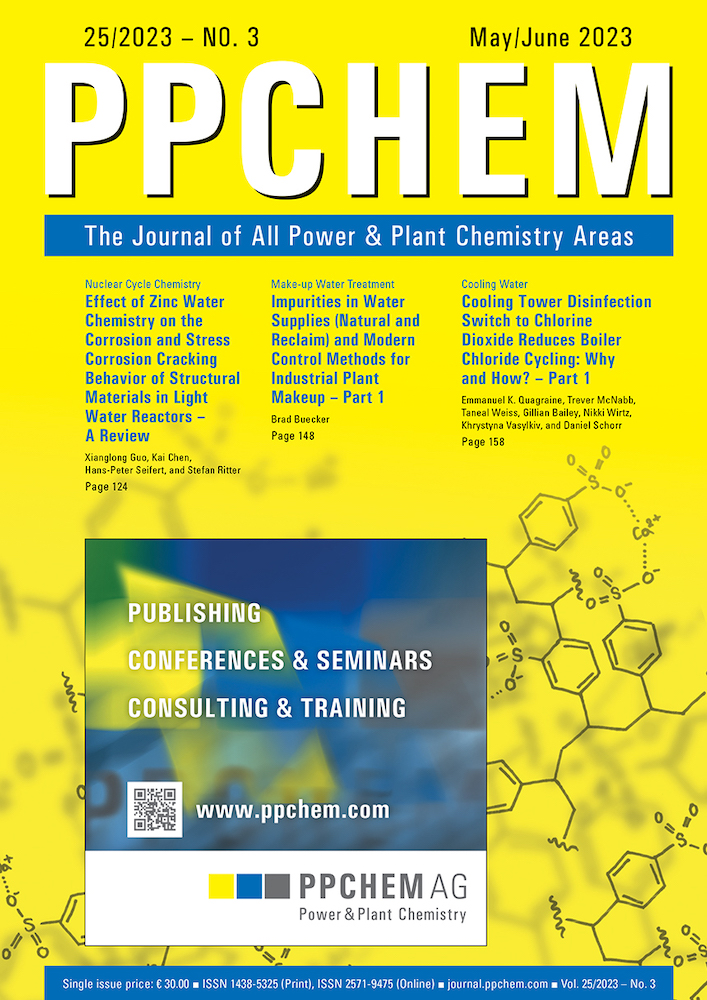
For members only
ABSTRACTS
Effect of Zinc Water Chemistry on the Corrosion and Stress Corrosion Cracking Behavior of Structural Materials in Light Water Reactors – A Review
Xianglong Guo, Kai Chen, Hans-Peter Seifert, and Stefan Ritter
Zinc (Zn) injection into light water reactor coolants has attracted increasing attention since the reporting of its positive effects on reducing the susceptibility to stress corrosion cracking (SCC) of steam generator tubes made of Alloy 600. Revealing the corrosion and SCC mechanisms of structural materials exposed to Zn water chemistry (ZWC) has gained importance in quantifying potential benefits for the safe long-term operation of nuclear reactors. This paper reviews the open literature on the current understanding of ZWC effects on the (uniform) corrosion and SCC behavior of structural materials used in western light water reactor plants. Some research with promising results has been conducted, but more detailed and systematic work is still needed to draw meaningful conclusions on the SCC mitigation capabilities of the ZWC.
PPCHEM® 2023, 25(3), 124–147
For Members only
Impurities in Water Supplies (Natural and Reclaim) and Modern Control Methods for Industrial Plant Makeup – Part 1
Brad Buecker
Makeup water for power and industrial plants typically contains numerous impurities. Many come from natural processes, while others, often in slight but at times potentially troublesome amounts, come from human activities. The contaminants can cause fouling, scaling, and other problems in cooling, service, and high-purity makeup systems unless treatment methods are employed to reduce impurity concentrations. This series examines how impurities enter water supplies, and it provides an overview of modern treatment methods.
PPCHEM® 2023, 25(3), 148–154
For Members only
Cooling Tower Disinfection Switch to Chlorine Dioxide Reduces Boiler Chloride Cycling: Why and How? – Part 1
Emmanuel K. Quagraine, Trever McNabb, Taneal Weiss, Gillian Bailey, Nikki Wirtz, Khrystyna Vasylkiv, and Daniel Schorr
This is the first half of a two-part article which discusses the abatement of selective boiler chloride cycling (SBCC), which has plagued the subject power plant, upon switching the recirculating cooling water (RCW) biocide from NaOCl to ClO2. Evidence has been given to attribute this mainly to gaseous ingress of volatile chlorinated compounds (VCCs) through weak tube-to-tubesheet joints. Based on Henry’s constants in aqueous solutions, ClO2 partitions more into the gaseous phase compared to chlorine species associated with NaOCl, i.e., chloramines, Cl2, HOCl, and OCl–. The SBCC abatement hence seems paradoxical. Based on literature and operational data, this is explained. Properties of ClO2 make keeping residual ClO2 in RCW difficult, if not impractical. At the cooling tower, major losses occur physically and chemically and even when residual remains, its high solubility in water at such low concentrations causes deviation from Henry’s law, i.e., a lower tendency to form ClO2(g). In addition, inside the condenser, where ClO2(g) may occur, it reacts quickly with oxidizable gases and (bio)organic compounds selectively yet versatilely, where it is not only consumed but avoids formation of VCCs, thereby preventing their ingress into the condensate side.
PPCHEM® 2023, 25(3), 158–174
For Members only
ERRATA
Nobody is perfect and everybody makes mistakes sometimes. We apologize to the authors and to our readers for the mistakes in these articles:
On the Usefulness of Bypass Clean-up Systems
Volker Ender and Jens Weber
PPCHEM® 2023, 25(2), 100–105
The corrected version of the paper (a PDF file)
is available to all readers here.
The details of the errata can be found in the pdf:
Some Basics of Power Plant Chemistry – Corrosion and Deposition
Frank Udo Leidich
PPCHEM® 2023, 25(1), 38–50


